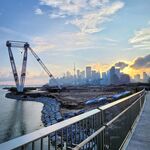Dan416
Senior Member
Well said Scarberian.
I really disliked Jane Pitfield, but at least she had the right idea of continual, on-going subway construction. Wikipedia states "She supported building two kilometres of subway per year".
So Sheppard East Don Mills to STC is about 8 km
Danforth Kennedy to STC is about 6 km
Sheppard West to Downsview is about 4 km
DRL Dundas West-Union-Pape-Eglinton 17 km
Eglinton Kennedy to Renforth 27 km
So if we had implemented Pitfield's plan, we could already have Sheppard West to Downsivew complete (as it's been 2 years, and 2 years x 2 km = 4 km, the length of the Sheppard extension to Downsview/Sheppard West). Or we could be 2/3 done Danforth to STC, or 1/2 done Sheppard East to STC.
I list the Sheppard East, Danforth East and Sheppard West extensions first because they're short, would help Sheppard become less of a stub, and would do a lot to fill out the subway network in the East.
Yonge North is happening anyway, so I'm not listing it. VCC I'm not listing because I don't agree with it in principal.
Eglinton and DRL are going to be the big bucks. They are both very large, very long-term plans. And we should be planning for them right now. And anyone who says Eglinton should be LRT should have the burden of proof on them that it will be as fast as a subway line.
I really disliked Jane Pitfield, but at least she had the right idea of continual, on-going subway construction. Wikipedia states "She supported building two kilometres of subway per year".
So Sheppard East Don Mills to STC is about 8 km
Danforth Kennedy to STC is about 6 km
Sheppard West to Downsview is about 4 km
DRL Dundas West-Union-Pape-Eglinton 17 km
Eglinton Kennedy to Renforth 27 km
So if we had implemented Pitfield's plan, we could already have Sheppard West to Downsivew complete (as it's been 2 years, and 2 years x 2 km = 4 km, the length of the Sheppard extension to Downsview/Sheppard West). Or we could be 2/3 done Danforth to STC, or 1/2 done Sheppard East to STC.
I list the Sheppard East, Danforth East and Sheppard West extensions first because they're short, would help Sheppard become less of a stub, and would do a lot to fill out the subway network in the East.
Yonge North is happening anyway, so I'm not listing it. VCC I'm not listing because I don't agree with it in principal.
Eglinton and DRL are going to be the big bucks. They are both very large, very long-term plans. And we should be planning for them right now. And anyone who says Eglinton should be LRT should have the burden of proof on them that it will be as fast as a subway line.




